Group Members (Group 5): Molly, Quilla, Sharon
From April 9 to April 26, I joined the Rube Goldberg Machine Program. The whole process is separated by five sessions: Info Session(4/9), Ideation Session(4/19), Building Session (4/23&4/24), Dry Run (4/25&4/26), Live Event (4/26).
Info Session(4/9)
On April 9 I attended the Info Session about Rube Goldberg Machine. In this session, I learned what Rube Goldberg Machine is and how the program would be. After the class, I made a group with Molly and spent one hour and a half to brainstorm our part for the Machine with Molly. Molly and I came up with many ideas through this brainstorm, which laid the foundation for our follow-up team’s operation route.
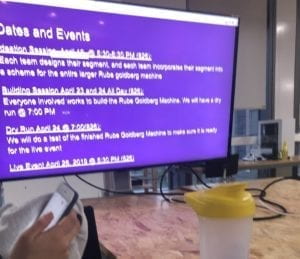
After the Info Session, I invited Quilla, who took Interaction Lab last semester, to join us to build the Goldberg Machine. On April 14, we gathered together and integrated our ideas. Finally, we determined our complete route, which will be explained later.
On April 15, we began to build the route. Before we started, we shared our idea with Nick. Nick suggested we simply our long route and try to make it practical and easier to realize. Therefore, after careful consideration, we decided to remove the Chinese shadow play and laser parts, which are hard to achieve and not so meaningful for our route. We then began our work.
Ideation Session(4/19)
In the Ideation Session, we met the other groups and shared our idea with professors and other students. Since our group’s idea had been formed before the session, after listening to the suggestions from the two professors in the ideation session, we made some small changes to our route, such as considering the connection between the two ends of the balance. After the Ideation Session, I summarized our ideas, documented them and submitted it to Leo. The doc is as follows:
We plan to use the dominoes and attach extra weight to the last domino and let it fall on one side of the scale. On the other side of the scale, there will be a magnet ball. After the last domino falls, the side of the scale with the ball will rise and hit the top of the track, and the ball will move on to the track. There will be LEDs along the track that turns on when the ball gradually passes by. The ball then falls into a specific spot of the sand table, starting to draw a simple pattern representing Shanghai (assumably the Oriental Pearl TV Tower). The mechanism of the drawing process is that the magnetic ball is attracted and driven by a robot underneath that draws the pattern. How the robot is triggered may be that it has sensed the pressure of the ball or the magnetic force from the ball. When the ball has finished drawing, it goes to a specific spot that has a magnet on top. It would be attracted to the magnet and trigger the next group.
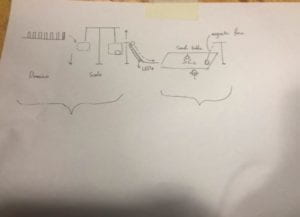
MATERIAL:
Dominoes
A scale
A magnet ball
LEDs
Track
Sand Table
Robotic car
Pressure sensor/Electromagnetic force sensor
Magnet
Building Session (4/23&4/24)
During the week of 4/23, we worked on the Goldberg Machine. I was in charge of the part from Domino to Bridge. I prepared the domino and the scale in advance. Quilla and I first worked on the bridge part. For the decoration, we used conductive tape, button batteries, and LEDs to make LEDs light up when the ball passes by.
After building the bridge, I worked on the scale and domino to make it be a smooth route using boxes and sponge blocks. And it worked on the table!
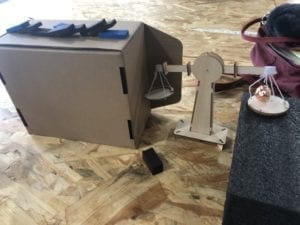
Dry Run (4/25&4/26)
Here I met the biggest problem: Since my part needs a certain height to operate, while the part of our previous group is output on the ground, connecting the two parts has become a big problem. After much thought, struggle, and modification, finally we decided to use a stick to trigger the domino. We made a stick using screws and components. But it was hard to make the stick work. In the first day of the test, we sometimes succeeded and sometimes failed (failure accounts for the majority).
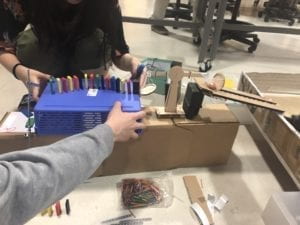
On the following day, in order to improve the success rate, I kept experimenting and finally found the secret to make it successful: make the top end of the stick close to the domino, and make the bottom end keep a certain distance from the domino. With this trick, our success rate has improved greatly, to almost ninety percent. I was so excited about what we had achieved and also a little worried about whether we could still succeed in the live event.
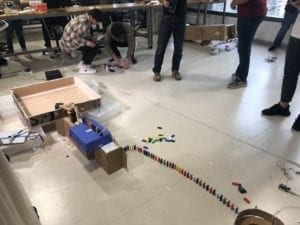
Live Event (4/26)
Excited! Our group’s work successfully operated!
After this project, I felt a sense of achievement through my own efforts to build the Goldberg Machine and the collective sense of cooperation with all the groups. Although I met with difficulties during the period, I finally overcame it and successfully achieved the expected goal. Due to the urgency of time, there are still some things we can do better in the project, such as the functions of LEDs are not well realized. We’ll pay more attention to time arrangement next time.